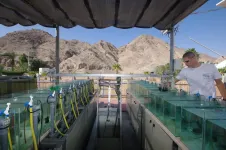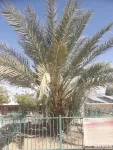Local impacts from fracking the Eagle Ford
Fracking and earthquakes
2021-05-03
(Press-News.org) Hydraulic fracturing to extract trapped fossil fuels can trigger earthquakes. Most are so small or far from homes and infrastructure that they may go unnoticed; others can rattle windows, sway light fixtures and jolt people from sleep; some have damaged buildings.
Stanford University geophysicists have simulated and mapped the risk of noticeable shaking and possible building damage from earthquakes caused by hydraulic fracturing at all potential fracking sites across the Eagle Ford shale formation in Texas, which has hosted some of the largest fracking-triggered earthquakes in the United States.
Published April 29 in Science, the results show the most densely populated areas - particularly a narrow section of the Eagle Ford nestled between San Antonio and Houston - face the greatest risk of experiencing shaking strong enough to damage buildings or be felt by people. "We found that risks from nuisance or damage varies greatly across space, depending mostly on population density," said lead study author Ryan Schultz, a PhD student in geophysics at Stanford.
Social license
Tens of thousands of wells drilled in the vast formation over the past decade helped to fuel the U.S. shale boom and contributed to a dramatic increase in earthquakes in the central and eastern U.S. starting around 2009. Although damaging earthquakes are rare, the authors write, "the perceived risks of hydraulic fracturing have both caused public concern and impeded industry development."
In sparsely populated areas within the southwestern portion of the Eagle Ford, the researchers found damage is unlikely even if fracking causes earthquakes as large as magnitude 5.0. Allowing such powerful quakes, however, could jeopardize the "social license to operate," they write. The phrase, which emerged within the mining industry in the 1990s and has since been adopted by climate activists, refers to the unofficial acceptance by local community members and broader civil society that oil, gas and mining operations need to do business without costly conflicts.
"Seismicity is part of the social license for hydraulic fracturing, but far from the only issue," said study co-author Bill Ellsworth, a geophysics research professor at Stanford's School of Earth, Energy & Environmental Sciences (Stanford Earth). "Eliminating hydraulic fracturing seismicity altogether wouldn't change any of the other concerns."
Among those concerns are health threats from living near oil and gas wells and greenhouse gas emissions from fossil fuel production and use. California's recent announcement of plans to stop issuing new permits for hydraulic fracturing by 2024, for example, comes as part of an effort to phase out oil extraction and reduce greenhouse gas emissions.
Starting with risk
The researchers say their goal is to make it easier for operators, regulators, local residents and property owners to discuss the risks that are important to them without technical expertise. "The approach we've developed provides the risk of nuisance or damage as a shared frame of reference and tools to evaluate it," said study co-author and geophysics professor Greg Beroza, co-director of the Stanford Center for Induced and Triggered Seismicity (SCITS).
The new risk analysis applies a technique first published last year for considering where people and structures are located as well as forecasts for maximum earthquake magnitude and geological factors that can amplify or dampen tremors as they travel underground. The approach makes it possible to start out with some level of risk - such as a 50 percent chance of 30 households experiencing shaking that feels exciting but not frightening, based on community questionnaires - and calculate the largest earthquake magnitude that would keep risk at or below that level.
The authors propose using this type of analysis as a starting point for managing earthquake risk caused by fracking using a system known as a traffic-light protocol. Adopted in states including Ohio and Oklahoma to manage seismic hazards related to oil, gas and some geothermal energy development, traffic-light protocols give operators a green light to proceed as long as quakes remain relatively small. Larger earthquakes may require an operator to adjust or halt fluid injections, knowing that shaking may continue and even intensify after the pumps shut down.
"If the goal is to treat everyone equally in terms of risk, our analysis shows action should be taken at lower magnitudes for drill sites near the cities in the north of the Eagle Ford than for those in rural areas in the south," explained Ellsworth, who is also a co-director of SCITS.
According to the researchers, it's "unfair" to set a uniform threshold for the amount of shaking allowed across a large formation like the Eagle Ford. "Single valued thresholds can allow for thresholds that are too permissive in urban regions or too restrictive in rural regions," said Beroza, the Wayne Loel Professor at Stanford Earth. "Instead, if you start with a tolerance to risk, you can set thresholds that vary according to changes in the risk."
INFORMATION:
Beroza is also co-director of the Southern California Earthquake Center (SCEC).
This research was supported by SCITS.
ELSE PRESS RELEASES FROM THIS DATE:
2021-05-03
ATLANTA--An influenza vaccine that is made of nanoparticles and administered through the nose enhances the body's immune response to influenza virus infection and offers broad protection against different viral strains, according to researchers in the Institute for Biomedical Sciences at Georgia State University.
Recurring seasonal flu epidemics and potential pandemics are among the most severe threats to public health. Current seasonal influenza vaccines induce strain-specific immunity and are less effective against mismatched strains. Broadly protective influenza vaccines are urgently needed.
Intranasal vaccines are a promising strategy for combatting ...
2021-05-03
BOSTON -- For the first time, researchers have shown how Mullerian inhibiting substance (MIS), also known as anti-Mullerian hormone, a key reproductive hormone, suppresses follicle development and prevents ovulation in females. "Understanding the mechanism of follicle development by MIS opens the door to creating novel approaches to contraception, preserving the eggs of young girls undergoing chemotherapy, enhancing the success of fertility treatment, and potentially delaying menopause," says David Pépin, PhD, an associate molecular biologist in the Department of Surgery at Massachusetts General Hospital (MGH) and senior author ...
2021-05-03
Even under the most optimistic scenarios, most of the coral reef ecosystems on our planet - whether in Australia, the Maldives or the Caribbean - will have disappeared or be in very bad shape by the end of this century. That's because global warming is pushing ocean temperatures above the limit that single-cell algae, which are corals' main allies, can withstand. These algae live inside coral tissue for protection and, in exchange, provide corals with essential nutrients produced through photosynthesis. Because the algae contain a variety of pigments and therefore give coral reefs their famous colors, if they are lost the corals turn white, which is known as coral bleaching. But in spite of the real threat caused by global warming, corals in the ...
2021-05-03
Abu Dhabi, UAE, May 3, 2021: Researchers from NYU Abu Dhabi's Center for Genomics and Systems Biology have successfully sequenced the genome of previously extinct date palm varieties that lived more than 2,000 years ago. They did so using date palm seeds that were recovered from archaeological sites in the southern Levant region and radiocarbon-dated from the 4th century BCE to the 2nd century CE. The seeds were germinated to yield viable, new plants. The researchers conducted whole genome sequencing of these germinated ancient samples and used this genome data to examine the genetics of these previously extinct Judean date palms. This study marks the first time researchers have sequenced the genomes of plants ...
2021-05-03
First-of-its-kind model replicates human alveolar lung tissue
Allows researchers to study effects of COVID-19 on cell growth and development
Provides insight as to how various drugs impact viral spread
Globally, lung failure is one of the leading causes of death. Many conditions can affect and damage the lungs, including asthma, chronic obstructive pulmonary disease, influenza, pneumonia, and, most recently, COVID-19. To better understand respiratory diseases and develop new drugs faster, investigators from Brigham and Women's Hospital designed a ...
2021-05-03
CHAMPAIGN, Ill. --A new study found overlooked tsunami hazards related to undersea, near-shore strike-slip faults, especially for coastal cities adjacent to faults that traverse inland bays. Several areas around the world may fall into this category, including the San Francisco Bay area, Izmit Bay in Turkey and the Gulf of Al-Aqaba in Egypt.
The study led by University of Illinois Urbana-Champaign civil and environmental engineering professor Ahmed Elbanna and professor Ares Rosakis of the California Institute of Technology used the Blue Waters supercomputer at the National Center for Supercomputing Applications to model ...
2021-05-03
ALBUQUERQUE, N.M. -- Sometime between 50,000 and 70,000 years ago, prehistoric humans took their first steps into Sahul, an ancient landmass made up of modern Australia, New Guinea and Tasmania. But nobody knows which way they went after that.
"One of the really big unanswered questions of prehistory is how Australia was populated in the distant past. Scholars have debated it for at least 150 years," said Sandia National Laboratories archaeologist and remote sensing scientist Devin White.
Now, an international team of scientists using a Sandia supercomputer in the largest reconstruction ...
2021-05-03
Palo Alto, CA--New work from a Stanford University-led team of researchers including Carnegie's Arthur Grossman and Tingting Xiang unravels a longstanding mystery about the relationship between form and function in the genetic material of a diverse group of algae called dinoflagellates.
Their findings, published in Nature Genetics, have implications for understanding genomic organizational principles of all organisms.
Dinoflagellates include more than 2,000 species of marine and freshwater plankton, many of which are photosynthetic, and some of which also ingest other organisms ...
2021-05-03
MADISON -- From radio to television to the internet, telecommunications transmissions are simply information carried on light waves and converted to electrical signals.
Silicon-based fiber optics are currently the best structures for high-speed, long distance transmissions, but graphene -- an all-carbon, ultra-thin and adaptable material -- could improve performance even more.
In a study published April 16 in ACS Photonics, University of Wisconsin-Madison researchers fabricated graphene into the smallest ribbon structures to date using a method that makes scaling-up simple. In tests with these tiny ribbons, ...
2021-05-03
SEATTLE--A new study of hospital deaths in the United States, published today in JAMA Network Open, is the most comprehensive look yet at changes in hospital mortality during the pandemic. Researchers analyzed data on more than 20,000 patients admitted to hospitals for COVID-19, over nine full months, from March to November of 2020. They found that rates of in-hospital mortality among COVID patients fell 38% between March and May, but there was little further decline through November 2020.
The researchers aimed to uncover the most likely cause of the ...
LAST 30 PRESS RELEASES:
[Press-News.org] Local impacts from fracking the Eagle Ford
Fracking and earthquakes



